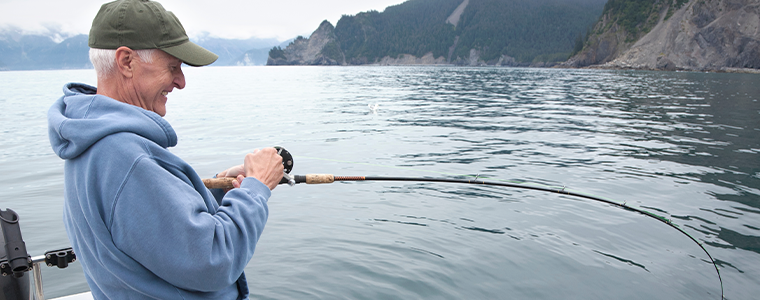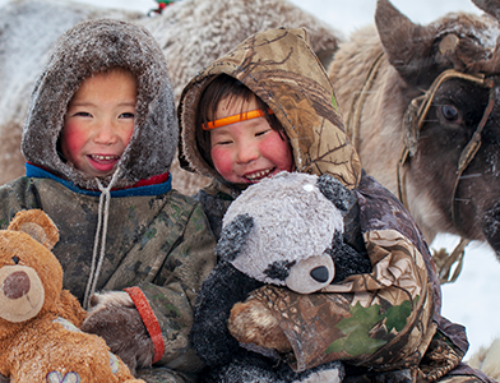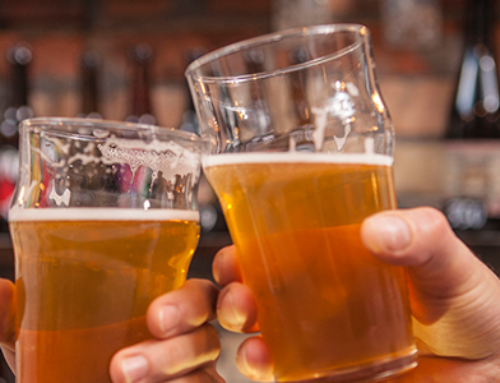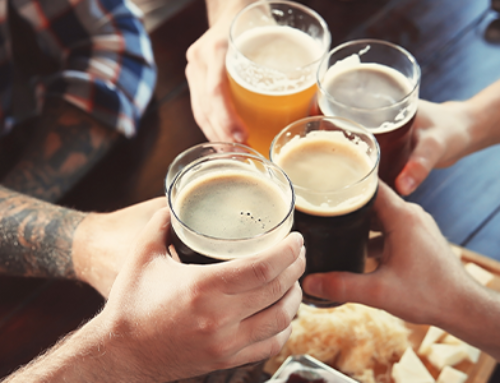For many visitors to Alaska, fishing is a can’t-miss activity. For many residents, it’s a way of life—a family pastime, a way to put dinner on the table, and a pathway to sustaining traditions and cultural practices.
Whether you’re considering a vacation in Alaska, planning a move to the Last Frontier, or researching Alaska’s wildlife regulations as a resident, we’ll show you everything you need to know about fishing in Alaska. We’ll cover:
- What kind of fishing you’ll find in Alaska for visitors and residents
- Whether you need a license for fishing in Alaska
- What kind of fish you can catch in Alaska
- Where to catch fish in Alaska
- The best times of year to fish in Alaska
First, let’s talk about the four types of fishing in Alaska so you can figure out the basics, including where you’re allowed to fish and what type of license you’ll need.
What Kind of Fishing Will You Find in Alaska?
You’ll see all kinds of people fishing in Alaska for all kinds of reasons. The Alaska Department of Fish and Game has set up four categories that make it easier to understand where you’re allowed to fish, what equipment you can use, and what you can do with the fish after you catch them.
Check out the four types of Alaska fishing below. If you want to dig deeper on the regulations, visit the ADF&G website.
Commercial Fishing
Alaska Residency: Not required
This category covers people who fish for the primary purpose of selling their catch, although they are allowed to barter or keep some of their catch for personal consumption. Commercial fishing operations are limited to seine nets, gillnets, or other gear. They are not allowed to use a rod and reel or dipnets.
Unless you’re moving to Alaska to work on a commercial fishing boat—or start a commercial fishing business of your own—you won’t fall under this category.
Sport Fishing
Alaska Residency: Not required
If you’re a tourist in Alaska who wants to spend time fishing, you’ll fall neatly into this category. ADF&G defines sport fishing as taking (or attempting to take) your catch by hook and line. There’s no residency requirement, but you’re not allowed to use dipnets, seine nets, or gillnets. Of course, if you go out with a hired guide or a charter company, they’ll handle everything to make sure you stay legal while enjoying a great day of fishing.
Personal Use Fishing
Alaska Residency: Must have lived in Alaska for at least a year to qualify.
Personal use is a defined category of fishing in Alaska that covers “the taking, fishing for, or possession of finfish, shellfish, or other fishery resources, by Alaska residents for personal use and not for sale or barter, with gill or dip net, seine, fish wheel, long line, or other means defined by the Board of Fisheries.” If you’re planning on moving to Alaska and feeding yourself and your family by fishing, this is the category you’ll fall into. Note that you’ll need to have lived in in Alaska for at least a year to qualify for residency.
If you want to engage in personal use fishing, you’ll need a valid Resident Sport Fishing License. The current price is $20 for the entire year. (If you want to add hunting and trapping to that license, it will cost a total of $85.) There are also a few regulations that cover personal use fishing, and they vary by region. You’ll find all of the regulations, plus a link to purchase your fishing license on the personal use fishing page on the ADF&G site.
Subsistence Use Fishing
Alaska Residency: Must have lived in Alaska for at least a year to qualify.
The subsistence use fishing category covers Alaska residents who gather wildlife resources for “non-commercial, customary, and traditional uses.” This includes personal consumption of these resources for purposes such as food, shelter, clothing, tools, and the creation of handicraft items.
In order to qualify for subsistence use fishing, you must be an Alaska resident with 12 consecutive months of residency. Both Alaska Natives and non-Natives are permitted to participate in subsistence fisheries in designated areas. However, there are several non-subsistence areas in Alaska where subsistence fishing isn’t allowed.
Non-Subsistence Areas in Alaska
- Ketchikan Non-Subsistence Area
- Juneau Non-Subsistence Area
- Anchorage, Matanuska/Susitna, and Kenai Non-Subsistence Area
- Fairbanks Non-Subsistence Area
- Valdez Non-Subsistence Area
Although subsistence use fishing doesn’t require a Resident Sport Fishing License, some subsistence use fisheries require a permit. You can find more guidelines for subsistence use fishing on the ADF&G website.
Do I Need a Fishing License in Alaska?
To sum it up, if you’re:
- A resident of Alaska who’s 18 years or older or a non-resident who’s 16 years or older, and…
- You’re participating in sport or personal use fishing…
…you’ll need to purchase a sport fishing license. Additionally, if you want to fish for king salmon, you’ll need a king salmon stamp. Licenses and stamps can be purchased online from the ADF&G website.
There are two exceptions:
- Alaska residents aged 60+
- Alaska residents who are disabled veterans
If you fall into either category, you don’t need a sport fishing license, but you do need an Identification Card from ADF&G. One you get your card, you’re eligible to take advantage of your fishing benefits.
Can Tourists Fish in Alaska?
Absolutely! As a tourist, you’ll fall under the sport fishing category. You may choose to go out with a guide or charter a boat. This is probably the fastest and easiest path to catching fish fast. Your guide or charter outfit will walk you through everything you need to know—and take you to the spots where you’re most likely to catch fish. If you’ve never fished in Alaska, hiring a guide or chartering a boat is a great way to maximize your fishing time in Alaska.
If you’ve already got some experience—or if you prefer to go it on your own—stop by a sporting goods store in Alaska for the proper licenses or get yours online.
Now that we’ve got the regulations laid out, let’s talk about the fun stuff: what kind of finfish and shellfish you’ll find in the waters surrounding Alaska.
What Kind of Fish Can I Catch in Alaska?
When the topic of fishing in Alaska comes up, most people think of one of two things: 1) the five types of Alaska salmon or 2) the Alaskan king crab and snow crab you see the crews haul in on Deadliest Catch.
The possibilities for catching finfish and shellfish in Alaska are pretty bountiful. They include:
- King Salmon / Chinook Salmon
- Oncorhynchus tshawytscha
- Sockeye Salmon / Red Salmon
- Oncorhynchus nerka
- Coho Salmon / Silver Salmon
- Oncorhynchus kisutch
- Pink Salmon / Humpy Salmon
- Oncorhynchus gorbuscha
- Chum Salmon / Dog Salmon
- Oncorhynchus keta
- Pacific Halibut
- Hippoglossus stenolepis
- Yelloweye Rockfish /
- Pacific Red Snapper
- Sebastes ruberrimus
- Black Rockfish / Black Bass
- Sebastes melanops
- Lingcod
- Ophiodon elongatus
- Dolly Varden Trout
- Salvelinus malma
- Alaskan King Crab
- Paralithodes camtschaticus
- Snow Crab
- Chionoecetes opilio
And this is just the start of what you’ll find in the waters in and around Alaska. For those who love to fish, Alaska really can feel like paradise.
Now that you know what’s out there, let’s talk about when you’ll find the best fishing in Alaska.
What’s the Best Month to Fish in Alaska?
May through September offer the biggest opportunities to catch fish—and that’s when the weather is most comfortable for being outdoors in Alaska.
Additionally, each type of fish will have its own season in which you’re allowed to catch up to your limit. Regulations depend on which of the four types of fishing you’re doing, as well as what region you’re fishing in. Follow this guide on the ADF&G site to see what kind of regulations you can expect.
By the way, you’ll still find fishing opportunities in the winter in Alaska! For example, king salmon can be found year-round near Homer. Additionally, many Alaska residents head to stocked ponds, which hold fish like trout, pike, rockfish, and arctic char.
A lot of Alaska winter fishing happens through ice. You’ll need specialized equipment for ice fishing, including ice augers for drilling holes in the ice and ice spuds/ice chisels for reopening fishing holes. Some people even build fishing houses—or bring their own portable ones—to make winter fishing more comfortable.
Exercise caution when walking on ice, especially in the early winter. If you’ve never done it before, buddy up with someone experienced so they can show you the ropes. Having a buddy also ensures you can assist each other, just in case anything goes sideways.
Finally, let’s talk about some of the best places to go in Alaska.
Where Are the Best Places to Fish in Alaska?
For sport fishing, the Kenai River offers tremendous king salmon, sockeye salmon, pink salmon, and silver salmon fishing. As we mentioned above, Homer also offers wintertime king salmon fishing. You’ll also find great halibut fishing in Homer, Seward, and Juneau. Finally, Bristol Bay is one of the richest areas for catching all types of salmon. It can also be a great jumping-off point for nearby fishing expeditions by plane or boat to catch fish like rainbow trout, Dolly Varden trout, and others.
Fresh Fish: It’s What’s for Dinner in Alaska
There’s nothing like fishing in Alaska—savoring your time in Alaska’s incredible outdoor landscape, the pride of providing your nightly meal, and, of course, the inimitable taste of the freshest catch possible. Whether you’re in Alaska for vacation or for a lifetime, the
the fun, the tradition, and the excitement is all available to you.
Considering a move to Alaska? Our experts would be happy to help you move your belongings to the Last Frontier (and maybe give you a few fishing tips, too)! Just reach out for a complimentary quote to get started.
Tell us about your move!
 (907) 868-4756
(907) 868-4756


